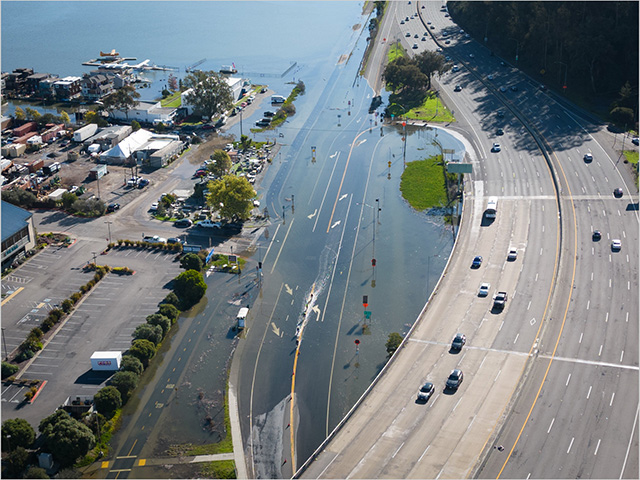Increasing Greenhouses Gases Are Warming the Planet
Scientists attribute the global warming trend observed since the mid-20th century to the human expansion of the "greenhouse effect"1 — warming that results when the atmosphere traps heat radiating from Earth toward space.
Life on Earth depends on energy coming from the Sun. About half the light energy reaching Earth's atmosphere passes through the air and clouds to the surface, where it is absorbed and radiated in the form of infrared heat. About 90% of this heat is then absorbed by greenhouse gases and re-radiated, slowing heat loss to space.
Gases that ContributeHuman Activity Is the Cause of Increased Greenhouse Gas Concentrations
Over the last century, burning of fossil fuels like coal and oil has increased the concentration of atmospheric carbon dioxide (CO2). This increase happens because the coal or oil burning process combines carbon with oxygen in the air to make CO2. To a lesser extent, clearing of land for agriculture, industry, and other human activities has increased concentrations of greenhouse gases.
The industrial activities that our modern civilization depends upon have raised atmospheric carbon dioxide levels by nearly 50% since 17502. This increase is due to human activities, because scientists can see a distinctive isotopic fingerprint in the atmosphere.
In its Sixth Assessment Report, the Intergovernmental Panel on Climate Change, composed of scientific experts from countries all over the world, concluded that it is unequivocal that the increase of CO2, methane, and nitrous oxide in the atmosphere over the industrial era is the result of human activities and that human influence is the principal driver of many changes observed across the atmosphere, ocean, cryosphere and biosphere.
"Since systematic scientific assessments began in the 1970s, the influence of human activity on the warming of the climate system has evolved from theory to established fact."
The panel's AR6 Working Group I (WGI) Summary for Policymakers report is online at https://www.ipcc.ch/report/ar6/wg1/.
Is the Sun to Blame?Evidence Shows That Current Global Warming Cannot Be Explained by Solar Irradiance
Scientists use a metric called Total Solar Irradiance (TSI) to measure the changes in energy the Earth receives from the Sun. TSI incorporates the 11-year solar cycle and solar flares/storms from the Sun's surface.
Studies show that solar variability has played a role in past climate changes. For example, a decrease in solar activity coupled with increased volcanic activity helped trigger the Little Ice Age.
The amount of solar energy that Earth receives has followed the Sun’s natural 11-year cycle of small ups and downs with no net increase since 1880. Over the same period, global temperature has risen markedly. It is therefore extremely unlikely that the Sun has caused the observed global temperature warming trend over the past half-century. Credit: NASA/JPL-Caltech
But several lines of evidence show that current global warming cannot be explained by changes in energy from the Sun:
References
-
IPCC 6th Assessment Report, WG1, Summary for Policy Makers, Sections A, “The Current State of the Climate”
IPCC 6th Assessment Report, WG1, Technical Summary, Sections TS.1.2, TS.2.1 and TS.3.1
-
P. Friedlingstein, et al., 2022: “Global Carbon Budget 2022”, Earth System Science Data (11 Nov 2022): 4811–4900. https://doi.org/10.5194/essd-14-4811-2022
-
IPCC 6th Assessment Report, WG1, Chapter 2, Section 2.2.1, “Solar and Orbital Forcing”
IPCC 6th Assessment Report, WG1, Chapter 7, Sections 7.3.4.4, 7.3.5.2, Figure 7.6, “Solar”
M. Lockwood and W.T. Ball, Placing limits on long-term variations in quiet-Sun irradiance and their contribution to total solar irradiance and solar radiative forcing of climate,” Proceedings of the Royal Society A, 476, issue 2228 (24 June 2020): https://doi 10.1098/rspa.2020.0077
Header image credit: Pixabay/stevepb

















